Xiaoling Wang
Hierarchical Safety Realignment: Lightweight Restoration of Safety in Pruned Large Vision-Language Models
May 22, 2025Abstract:With the increasing size of Large Vision-Language Models (LVLMs), network pruning techniques aimed at compressing models for deployment in resource-constrained environments have garnered significant attention. However, we observe that pruning often leads to a degradation in safety performance. To address this issue, we present a novel and lightweight approach, termed Hierarchical Safety Realignment (HSR). HSR operates by first quantifying the contribution of each attention head to safety, identifying the most critical ones, and then selectively restoring neurons directly within these attention heads that play a pivotal role in maintaining safety. This process hierarchically realigns the safety of pruned LVLMs, progressing from the attention head level to the neuron level. We validate HSR across various models and pruning strategies, consistently achieving notable improvements in safety performance. To our knowledge, this is the first work explicitly focused on restoring safety in LVLMs post-pruning.
AutoMedEval: Harnessing Language Models for Automatic Medical Capability Evaluation
May 17, 2025Abstract:With the proliferation of large language models (LLMs) in the medical domain, there is increasing demand for improved evaluation techniques to assess their capabilities. However, traditional metrics like F1 and ROUGE, which rely on token overlaps to measure quality, significantly overlook the importance of medical terminology. While human evaluation tends to be more reliable, it can be very costly and may as well suffer from inaccuracies due to limits in human expertise and motivation. Although there are some evaluation methods based on LLMs, their usability in the medical field is limited due to their proprietary nature or lack of expertise. To tackle these challenges, we present AutoMedEval, an open-sourced automatic evaluation model with 13B parameters specifically engineered to measure the question-answering proficiency of medical LLMs. The overarching objective of AutoMedEval is to assess the quality of responses produced by diverse models, aspiring to significantly reduce the dependence on human evaluation. Specifically, we propose a hierarchical training method involving curriculum instruction tuning and an iterative knowledge introspection mechanism, enabling AutoMedEval to acquire professional medical assessment capabilities with limited instructional data. Human evaluations indicate that AutoMedEval surpasses other baselines in terms of correlation with human judgments.
Unified Attacks to Large Language Model Watermarks: Spoofing and Scrubbing in Unauthorized Knowledge Distillation
Apr 24, 2025Abstract:Watermarking has emerged as a critical technique for combating misinformation and protecting intellectual property in large language models (LLMs). A recent discovery, termed watermark radioactivity, reveals that watermarks embedded in teacher models can be inherited by student models through knowledge distillation. On the positive side, this inheritance allows for the detection of unauthorized knowledge distillation by identifying watermark traces in student models. However, the robustness of watermarks against scrubbing attacks and their unforgeability in the face of spoofing attacks under unauthorized knowledge distillation remain largely unexplored. Existing watermark attack methods either assume access to model internals or fail to simultaneously support both scrubbing and spoofing attacks. In this work, we propose Contrastive Decoding-Guided Knowledge Distillation (CDG-KD), a unified framework that enables bidirectional attacks under unauthorized knowledge distillation. Our approach employs contrastive decoding to extract corrupted or amplified watermark texts via comparing outputs from the student model and weakly watermarked references, followed by bidirectional distillation to train new student models capable of watermark removal and watermark forgery, respectively. Extensive experiments show that CDG-KD effectively performs attacks while preserving the general performance of the distilled model. Our findings underscore critical need for developing watermarking schemes that are robust and unforgeable.
HSACNet: Hierarchical Scale-Aware Consistency Regularized Semi-Supervised Change Detection
Apr 18, 2025Abstract:Semi-supervised change detection (SSCD) aims to detect changes between bi-temporal remote sensing images by utilizing limited labeled data and abundant unlabeled data. Existing methods struggle in complex scenarios, exhibiting poor performance when confronted with noisy data. They typically neglect intra-layer multi-scale features while emphasizing inter-layer fusion, harming the integrity of change objects with different scales. In this paper, we propose HSACNet, a Hierarchical Scale-Aware Consistency regularized Network for SSCD. Specifically, we integrate Segment Anything Model 2 (SAM2), using its Hiera backbone as the encoder to extract inter-layer multi-scale features and applying adapters for parameter-efficient fine-tuning. Moreover, we design a Scale-Aware Differential Attention Module (SADAM) that can precisely capture intra-layer multi-scale change features and suppress noise. Additionally, a dual-augmentation consistency regularization strategy is adopted to effectively utilize the unlabeled data. Extensive experiments across four CD benchmarks demonstrate that our HSACNet achieves state-of-the-art performance, with reduced parameters and computational cost.
Latent-space adversarial training with post-aware calibration for defending large language models against jailbreak attacks
Jan 18, 2025Abstract:Ensuring safety alignment has become a critical requirement for large language models (LLMs), particularly given their widespread deployment in real-world applications. However, LLMs remain susceptible to jailbreak attacks, which exploit system vulnerabilities to bypass safety measures and generate harmful outputs. Although numerous defense mechanisms based on adversarial training have been proposed, a persistent challenge lies in the exacerbation of over-refusal behaviors, which compromise the overall utility of the model. To address these challenges, we propose a Latent-space Adversarial Training with Post-aware Calibration (LATPC) framework. During the adversarial training phase, LATPC compares harmful and harmless instructions in the latent space and extracts safety-critical dimensions to construct refusal features attack, precisely simulating agnostic jailbreak attack types requiring adversarial mitigation. At the inference stage, an embedding-level calibration mechanism is employed to alleviate over-refusal behaviors with minimal computational overhead. Experimental results demonstrate that, compared to various defense methods across five types of jailbreak attacks, LATPC framework achieves a superior balance between safety and utility. Moreover, our analysis underscores the effectiveness of extracting safety-critical dimensions from the latent space for constructing robust refusal feature attacks.
Hierarchical Divide-and-Conquer for Fine-Grained Alignment in LLM-Based Medical Evaluation
Jan 12, 2025Abstract:In the rapidly evolving landscape of large language models (LLMs) for medical applications, ensuring the reliability and accuracy of these models in clinical settings is paramount. Existing benchmarks often focus on fixed-format tasks like multiple-choice QA, which fail to capture the complexity of real-world clinical diagnostics. Moreover, traditional evaluation metrics and LLM-based evaluators struggle with misalignment, often providing oversimplified assessments that do not adequately reflect human judgment. To address these challenges, we introduce HDCEval, a Hierarchical Divide-and-Conquer Evaluation framework tailored for fine-grained alignment in medical evaluation. HDCEval is built on a set of fine-grained medical evaluation guidelines developed in collaboration with professional doctors, encompassing Patient Question Relevance, Medical Knowledge Correctness, and Expression. The framework decomposes complex evaluation tasks into specialized subtasks, each evaluated by expert models trained through Attribute-Driven Token Optimization (ADTO) on a meticulously curated preference dataset. This hierarchical approach ensures that each aspect of the evaluation is handled with expert precision, leading to a significant improvement in alignment with human evaluators.
NLSR: Neuron-Level Safety Realignment of Large Language Models Against Harmful Fine-Tuning
Dec 17, 2024Abstract:The emergence of finetuning-as-a-service has revealed a new vulnerability in large language models (LLMs). A mere handful of malicious data uploaded by users can subtly manipulate the finetuning process, resulting in an alignment-broken model. Existing methods to counteract fine-tuning attacks typically require substantial computational resources. Even with parameter-efficient techniques like LoRA, gradient updates remain essential. To address these challenges, we propose \textbf{N}euron-\textbf{L}evel \textbf{S}afety \textbf{R}ealignment (\textbf{NLSR}), a training-free framework that restores the safety of LLMs based on the similarity difference of safety-critical neurons before and after fine-tuning. The core of our framework is first to construct a safety reference model from an initially aligned model to amplify safety-related features in neurons. We then utilize this reference model to identify safety-critical neurons, which we prepare as patches. Finally, we selectively restore only those neurons that exhibit significant similarity differences by transplanting these prepared patches, thereby minimally altering the fine-tuned model. Extensive experiments demonstrate significant safety enhancements in fine-tuned models across multiple downstream tasks, while greatly maintaining task-level accuracy. Our findings suggest regions of some safety-critical neurons show noticeable differences after fine-tuning, which can be effectively corrected by transplanting neurons from the reference model without requiring additional training. The code will be available at \url{https://github.com/xinykou/NLSR}
ACE-$M^3$: Automatic Capability Evaluator for Multimodal Medical Models
Dec 16, 2024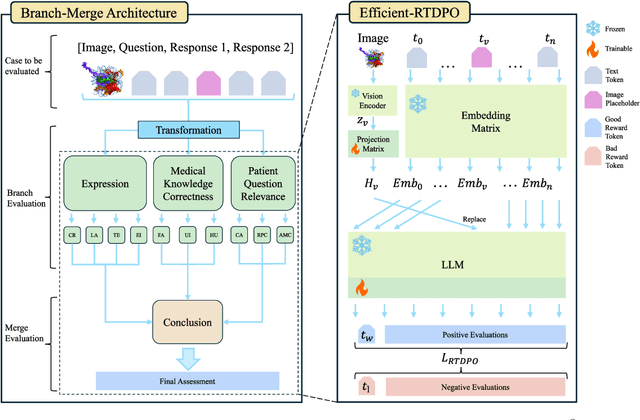

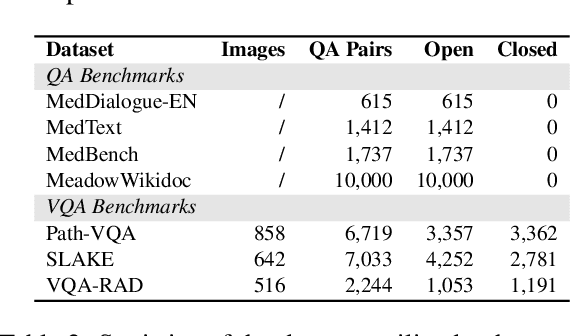
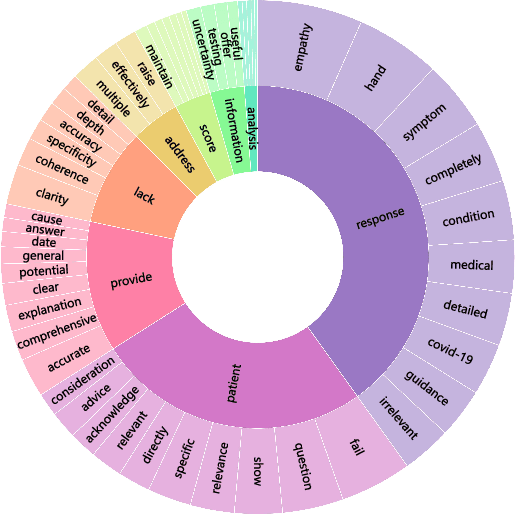
Abstract:As multimodal large language models (MLLMs) gain prominence in the medical field, the need for precise evaluation methods to assess their effectiveness has become critical. While benchmarks provide a reliable means to evaluate the capabilities of MLLMs, traditional metrics like ROUGE and BLEU employed for open domain evaluation only focus on token overlap and may not align with human judgment. Although human evaluation is more reliable, it is labor-intensive, costly, and not scalable. LLM-based evaluation methods have proven promising, but to date, there is still an urgent need for open-source multimodal LLM-based evaluators in the medical field. To address this issue, we introduce ACE-$M^3$, an open-sourced \textbf{A}utomatic \textbf{C}apability \textbf{E}valuator for \textbf{M}ultimodal \textbf{M}edical \textbf{M}odels specifically designed to assess the question answering abilities of medical MLLMs. It first utilizes a branch-merge architecture to provide both detailed analysis and a concise final score based on standard medical evaluation criteria. Subsequently, a reward token-based direct preference optimization (RTDPO) strategy is incorporated to save training time without compromising performance of our model. Extensive experiments have demonstrated the effectiveness of our ACE-$M^3$ model\footnote{\url{https://huggingface.co/collections/AIUSRTMP/ace-m3-67593297ff391b93e3e5d068}} in evaluating the capabilities of medical MLLMs.
Typicalness-Aware Learning for Failure Detection
Nov 04, 2024



Abstract:Deep neural networks (DNNs) often suffer from the overconfidence issue, where incorrect predictions are made with high confidence scores, hindering the applications in critical systems. In this paper, we propose a novel approach called Typicalness-Aware Learning (TAL) to address this issue and improve failure detection performance. We observe that, with the cross-entropy loss, model predictions are optimized to align with the corresponding labels via increasing logit magnitude or refining logit direction. However, regarding atypical samples, the image content and their labels may exhibit disparities. This discrepancy can lead to overfitting on atypical samples, ultimately resulting in the overconfidence issue that we aim to address. To tackle the problem, we have devised a metric that quantifies the typicalness of each sample, enabling the dynamic adjustment of the logit magnitude during the training process. By allowing atypical samples to be adequately fitted while preserving reliable logit direction, the problem of overconfidence can be mitigated. TAL has been extensively evaluated on benchmark datasets, and the results demonstrate its superiority over existing failure detection methods. Specifically, TAL achieves a more than 5% improvement on CIFAR100 in terms of the Area Under the Risk-Coverage Curve (AURC) compared to the state-of-the-art. Code is available at https://github.com/liuyijungoon/TAL.
Online Convex Optimization with Memory and Limited Predictions
Oct 31, 2024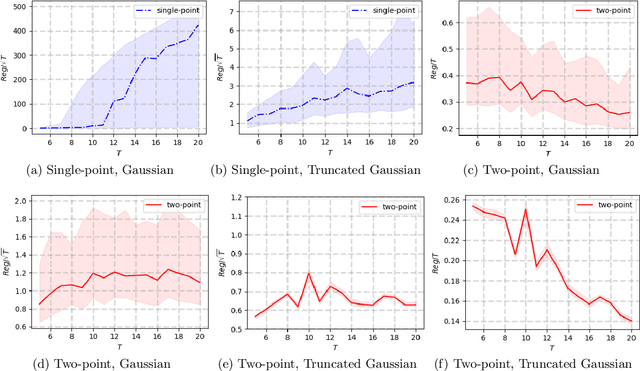
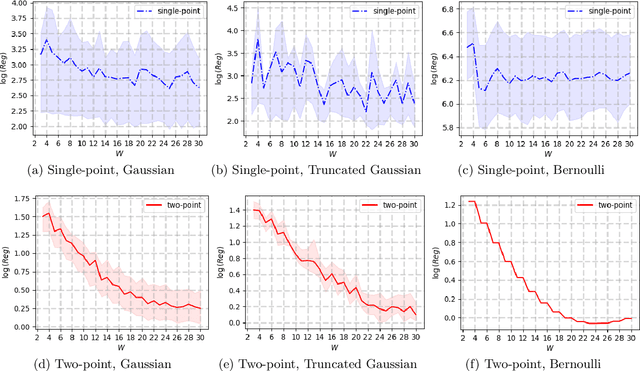
Abstract:We study the problem of online convex optimization with memory and predictions over a horizon $T$. At each time step, a decision maker is given some limited predictions of the cost functions from a finite window of future time steps, i.e., values of the cost function at certain decision points in the future. The decision maker then chooses an action and incurs a cost given by a convex function that depends on the actions chosen in the past. We propose an algorithm to solve this problem and show that the dynamic regret of the algorithm decays exponentially with the prediction window length. Our algorithm contains two general subroutines that work for wider classes of problems. The first subroutine can solve general online convex optimization with memory and bandit feedback with $\sqrt{T}$-dynamic regret with respect to $T$. The second subroutine is a zeroth-order method that can be used to solve general convex optimization problems with a linear convergence rate that matches the best achievable rate of first-order methods for convex optimization. The key to our algorithm design and analysis is the use of truncated Gaussian smoothing when querying the decision points for obtaining the predictions. We complement our theoretical results using numerical experiments.
 Add to Chrome
Add to Chrome Add to Firefox
Add to Firefox Add to Edge
Add to Edge